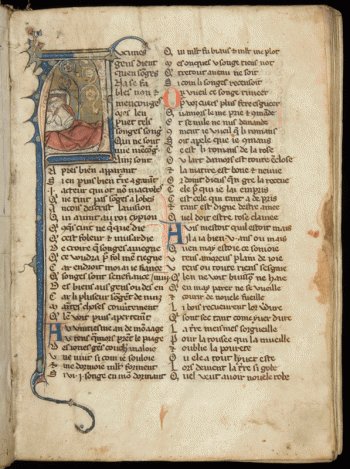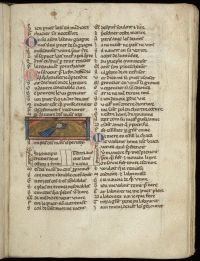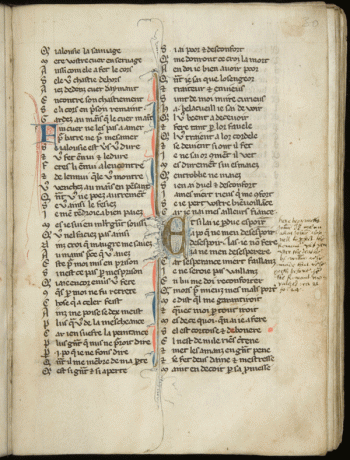Roman de la rose
As summer reaches its height, and town gardens and country hedgerows alike bombard our senses with the heady scent and glorious bloom of roses, we turn our spotlight on the Roman de la rose (Manuscript G.5).
 The Romance of the rose was one of the best known and most influential texts of the French Middle Ages. A lengthy allegorical love poem, the Rose was written in the thirteenth century, and is the work of two authors. It was begun in around 1230 by Guillaume de Lorris, who wrote the first 4000 lines, and then continued some forty years later by Jean de Meun, who added a further 18000 lines. The narrator, Amant (the Lover), tells of dream he had of entering a beautiful garden, where he fell in love with a rosebud seen reflected in the water of the fountain of Narcissus. The two authors approach the story in rather different ways. Guillaume de Lorris tells an instructive tale of the art of courtly love, which Jean de Meun concludes with a distinctly bawdier account of the deceitful plucking of the Rose, which along the way also gives valuable insights into 13th century thought and learning.
The Romance of the rose was one of the best known and most influential texts of the French Middle Ages. A lengthy allegorical love poem, the Rose was written in the thirteenth century, and is the work of two authors. It was begun in around 1230 by Guillaume de Lorris, who wrote the first 4000 lines, and then continued some forty years later by Jean de Meun, who added a further 18000 lines. The narrator, Amant (the Lover), tells of dream he had of entering a beautiful garden, where he fell in love with a rosebud seen reflected in the water of the fountain of Narcissus. The two authors approach the story in rather different ways. Guillaume de Lorris tells an instructive tale of the art of courtly love, which Jean de Meun concludes with a distinctly bawdier account of the deceitful plucking of the Rose, which along the way also gives valuable insights into 13th century thought and learning.
While most medieval vernacular texts survive in just a handful of copies, there are over 300 manuscripts and manuscript fragments of all or parts of this poem, dating from the 13th to the 16th centuries, reflecting its popularity. The surviving manuscripts come in a variety of forms. The most spectacular illuminated manuscripts were made for the French royal court and nobility. Some remain in pristine condition, possibly hardly ever opened. Other examples are very much less fine, well-thumbed, and sometimes annotated, showing how the text was read and interpreted throughout its history. Examples of Rose manuscripts can be found in the Roman de la Rose Digital Library at http://romandelarose.org/
 The copy of the Roman de la rose owned by St John's dates from the fourteenth century and is bound with two other French texts. It is not one of the finest manuscripts, but it is well written in a round hand, and the text is neatly set out with decoration in red, blue and gold. It begins with an opening initial incorporating a man in bed and a rose tree, and has a small miniature of a forearm in a blue sleeve and an extended left hand, on a gold ground on a later folio. The wear on the pages and occasional annotations suggest that it is a book that has been used and read with interest.
The copy of the Roman de la rose owned by St John's dates from the fourteenth century and is bound with two other French texts. It is not one of the finest manuscripts, but it is well written in a round hand, and the text is neatly set out with decoration in red, blue and gold. It begins with an opening initial incorporating a man in bed and a rose tree, and has a small miniature of a forearm in a blue sleeve and an extended left hand, on a gold ground on a later folio. The wear on the pages and occasional annotations suggest that it is a book that has been used and read with interest.
The volume came to St John's via the Earl of Southampton in 1635, from the library of William Crashaw.
This Special Collections Spotlight article was contributed on 24 June 2014 by Kathryn McKee, Special Collections Librarian.
